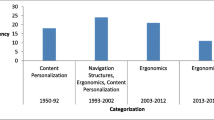Abstract
This article presents an interface adaptation methodology to hypermedia systems based on the methodology developed by Barbosa [1], where the site development with breast cancer contents is used to refine the students’ knowledge of the healthy area of UFSC who receive in their classroom. While this system was been developed it was defined the adaptation will only occur in the interface shown to the user with the use of different medias during the presentation of the contents which are introduced according to the individual characteristics of the students based on the Multiple Intelligence Theory (MI).
Access this chapter
Tax calculation will be finalised at checkout
Purchases are for personal use only
Preview
Unable to display preview. Download preview PDF.
Similar content being viewed by others
Referências
Barbosa, A T. R.; 2004. Mecanismo de Adaptação Baseado em Redes Neurais Artificiais para Sistemas Hipermídia Adaptativos. Tese de Doutorado — Programa de Pós graduação em Engenharia Elétrica, UFSC, Florianópolis, SC. 122p.
Gardner, H. Estruturas da Mente, Porto Alegre, RS.: Editora Artmed, 2001.
Armstrong, T. Sete Tipos de Inteligências — Identifique e Desenvolva suas Múltiplas Inteligências. Rio de Janeiro: Editora Record. 1999.
Antunes, C. Como desenvolver conteúdos explorando as inteligências Múltiplas. Fascículo 3, Petrópolis, RJ: Editora Vozes, 2001.
Haykin, S. Redes Neurais: Princípios e prática. 2a ed. Porto Alegre: Bookman. 2001.
Brusilovsky, P. Methods and techniques of adaptive hypermedia. User Modeling and User-Adapted Interaction (1998), 1–43.
Brusilowsky, P. Methods and Techniques of Adaptive Hypermedia. User Modeling and User Adapted Interaction, v.6, p 2. 1996.
Jasmine, Teatching with multiple intelligences. Westminster: Teacher Created Materials, Inc. 1996.
Brusilovsky, P.; Pesin, L. Adaptive Navigation Support in Educational Hypermedia: An Evaluation of the ISIS-TUTOR. In: Journal of Computing and Information Technology, 1998.
Author information
Authors and Affiliations
Editor information
Editors and Affiliations
Rights and permissions
Copyright information
© 2007 Springer-Verlag Berlin Heidelberg
About this paper
Cite this paper
Paim, R.L., de Azevedo, F.M., Koerich, G.M., Dufloth, R.M., Vieira, D.S.C., Possa, P.R.C. (2007). Sistema Hipermídia com Interface Adaptativa usando Redes Neurais Artificiais MLP e IAC. In: Müller-Karger, C., Wong, S., La Cruz, A. (eds) IV Latin American Congress on Biomedical Engineering 2007, Bioengineering Solutions for Latin America Health. IFMBE Proceedings, vol 18. Springer, Berlin, Heidelberg. https://doi.org/10.1007/978-3-540-74471-9_254
Download citation
DOI: https://doi.org/10.1007/978-3-540-74471-9_254
Publisher Name: Springer, Berlin, Heidelberg
Print ISBN: 978-3-540-74470-2
Online ISBN: 978-3-540-74471-9
eBook Packages: EngineeringEngineering (R0)




